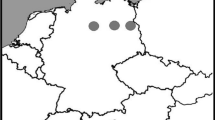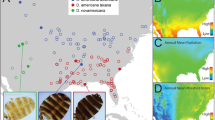Abstract
The long-term persistence of the ‘ancient asexual’ bdelloid rotifers, a clade of small aquatic invertebrates, is often tied to their ability to enter anhydrobiosis. This ability has both clear benefits (e.g. survival of desiccating conditions), but offers considerable costs (e.g. subsequent repair of the genome as well as physiological and metabolic costs to re-establish the phenotype). Despite these costs, several studies show that the time spent dry is effectively ignored with respect to life expectancy (the Sleeping Beauty hypothesis) and that reconstruction of the genome after a desiccation event might even be necessary to repair mistakes accumulated in it from obligate parthenogenesis while the animals were active. We propose that this genomic repair might not derive exclusively because desiccation per se, but could also result from genetic exchange that appears to occur between individuals during this time. By comparing individuals of Philodina roseola Ehrenberg, 1832 desiccated in groups versus individually, we document costs to desiccation in the isolated treatment group that impact negatively on lifespan and reproduction. In addition, comparing both groups with continuously active individuals reveals no strong evidence for the Sleeping Beauty hypothesis in this species nor any decline in fitness over a six-month period for the latter group. Finally, many treatment effects are at least partly heritable and were found in the untreated F1 generations. In particular, individuals desiccated in groups and their offspring could both reproduce faster than the offspring of continuously active individuals. Thus, our results offer additional support for the hypothesis of genetic exchange occurring during desiccation events in P. roseola and highlight the importance of considering this factor, and desiccation in general, in explaining bdelloid fitness. Moreover, our results provide additional context for understanding how the genetic information of bdelloids is ultimately shaped.

Similar content being viewed by others
References
Arkhipova, I., & Meselson, M. (2000). Transposable elements in sexual and ancient asexual taxa. Proceedings of the National Academy of Sciences of the United States of America, 97(26), 14473–14477. https://doi.org/10.1073/pnas.97.26.14473.
Bininda-Emonds, O. R. P., Hinz, C., & Ahlrichs, W. H. (2016). Evidence for the uptake and genomic incorporation of environmental DNA in the “ancient asexual” bdelloid rotifer Philodina roseola. Life, 6(3), 38.
Bohonak, A. J., & Jenkins, D. G. (2003). Ecological and evolutionary significance of dispersal by freshwater invertebrates. Ecology Letters, 6(8), 783–796. https://doi.org/10.1046/j.1461-0248.2003.00486.x.
Boschetti, C., Pouchkina-Stantcheva, N., Hoffmann, P., & Tunnacliffe, A. (2011). Foreign genes and novel hydrophilic protein genes participate in the desiccation response of the bdelloid rotifer Adineta ricciae. [article]. Journal of Experimental Biology, 214(1), 59–68. https://doi.org/10.1242/jeb.050328.
Caprioli, M., & Ricci, C. (2001). Recipes for successful anhydrobiosis in bdelloid rotifers. Hydrobiologia, 446, 13–17.
Debortoli, N., Li, X., Eyres, I., Fontaneto, D., Hespeels, B., Tang, C. Q., Flot, J. F., & van Doninck, K. (2016). Genetic exchange among bdelloid rotifers is more likely due to horizontal gene transfer than to meiotic sex. Current Biology, 26(6), 723–732.
Eyres, I., Boschetti, C., Crisp, A., Smith, T. P., Fontaneto, D., Tunnacliffe, A., & Barraclough, T. G. (2015). Horizontal gene transfer in bdelloid rotifers is ancient, ongoing and more frequent in species from desiccating habitats. BMC Biology, 13(1), 90. https://doi.org/10.1186/s12915-015-0202-9.
Eyres, I., Frangedakis, E., Fontaneto, D., Herniou, E. A., Boschetti, C., Carr, A., Micklem, G., Tunnacliffe, A., & Barraclough, T. G. (2012). Multiple functionally divergent and conserved copies of alpha tubulin in bdelloid rotifers. [article]. BMC Evolutionary Biology, 12, 148. https://doi.org/10.1186/1471-2148-12-148.
Flatt, T. (2011). Survival costs of reproduction in Drosophila. Experimental Gerontology, 46, 369–375.
Flot, J.-F., Hespeels, B., Li, X., Noel, B., Arkhipova, I., Danchin, E. G. J., Hejnol, A., Henrissat, B., Koszul, R., Aury, J. M., Barbe, V., Barthélémy, R. M., Bast, J., Bazykin, G. A., Chabrol, O., Couloux, A., da Rocha, M., da Silva, C., Gladyshev, E., Gouret, P., Hallatschek, O., Hecox-Lea, B., Labadie, K., Lejeune, B., Piskurek, O., Poulain, J., Rodriguez, F., Ryan, J. F., Vakhrusheva, O. A., Wajnberg, E., Wirth, B., Yushenova, I., Kellis, M., Kondrashov, A. S., Mark Welch, D. B., Pontarotti, P., Weissenbach, J., Wincker, P., Jaillon, O., & van Doninck, K. (2013). Genomic evidence for ameiotic evolution in the bdelloid rotifer Adineta vaga. [letter]. Nature, 500(4), 453–457. https://doi.org/10.1038/nature12326.
Gladyshev, E., & Meselson, M. (2008). Extreme resistance of bdelloid rotifers to ionizing radiation. Proceedings of the National Academy of Sciences of the United States of America, 105(13), 5139–5144. https://doi.org/10.1073/pnas.0800966105.
Gladyshev, E. A., & Arkhipova, I. R. (2010). Genome structure of bdelloid rotifers: shaped by asexuality or desiccation? Journal of Heredity, 101(Supplement 1), S85–S93. https://doi.org/10.1093/jhered/esq008.
Gladyshev, E. A., Meselson, M., & Arkhipova, I. R. (2008). Massive horizontal gene transfer in bdelloid rotifers. Science, 320(5880), 1210–1213. https://doi.org/10.1126/science.1156407.
Goddard, M. R., Godfray, H. C. J., & Burt, A. (2005). Sex increases the efficacy of natural selection in experimental yeast populations. Nature, 434(7033), 636–640. https://doi.org/10.1038/nature03405.
Harshmann, L. G., & Zera, A. J. (2007). The cost of reproduction: the devil in the details. Trends in Ecology & Evolution, 22, 80–86.
Hengherr, S., Brümmer, F., & Schill, R. O. (2008). Anhydrobiosis in tardigrades and its effects on longevity traits. Journal of Zoology, 275(3), 216–220. https://doi.org/10.1111/j.1469-7998.2008.00427.x.
Hickernell, L. M. (1917). A study of desiccation in the rotifer, Philodina roseola, with special reference to cytological changes accompanying desiccation. Biological Bulletin, 32(6), 343–406.
Keightley, P. D., & Eyre-Walker, A. (2000). Deleterious mutations and the evolution of sex. Science, 290(5490), 331–333. https://doi.org/10.1126/science.290.5490.331.
Kilham, S., Kreeger, D., Lynn, S., Goulden, C., & Herrera, L. (1998). COMBO: a defined freshwater culture medium for algae and zooplankton. Hydrobiologia, 377(1), 147–159. https://doi.org/10.1023/a:1003231628456.
Marotta, R., Uggetti, A., Ricci, C., Leasi, F., & Melone, G. (2012). Surviving starvation: changes accompanying starvation tolerance in a bdelloid rotifer. Journal of Morphology, 273(1), 1–7. https://doi.org/10.1002/jmor.11000.
Otto, S. P., & Lenormand, T. (2002). Resolving the paradox of sex and recombination. Nature Reviews Genetics, 3(4), 252–261. https://doi.org/10.1038/nrg761.
Poinar, G. O., & Ricci, C. (1992). Bdelloid rotifers in Dominican amber: evidence for parthenogenetic continuity. Cellular and Molecular Life Sciences, 48(4), 408–410. https://doi.org/10.1007/bf01923444.
Development Core Team, R. (2005). R: a language and environment for statistical computing. Vienna: R Foundation for Statistical Computing.
Ricci, C. (1998). Anhydrobiotic capabilities of bdelloid rotifers. Hydrobiologia, 387, 321–326.
Ricci, C. (2001). Dormancy patterns in rotifers. Hydrobiologia, 446, 1–11.
Ricci, C. (2016). Bdelloid rotifers: ‘sleeping beauties’ and ‘evolutionary scandals’, but not only. Hydrobiologia, 796, 277–285. https://doi.org/10.1007/s10750-016-2919-z.
Ricci, C., & Caprioli, M. (2005). Anhydrobiosis in bdelloid species, populations and individuals. Integrative and Comparative Biology, 45(5), 759–763.
Ricci, C., Caprioli, M., & Fontaneto, D. (2007). Stress and fitness in parthenogens: is dormancy a key feature for bdelloid rotifers? BMC Evolutionary Biology, 7(Suppl 2), S9. https://doi.org/10.1186/1471-2148-7-s2-s9.
Ricci, C., Caprioli, M., & Santo, N. (2004). Feeding and anhydrobiosis in bdelloid rotifers: a preparatory study for an experiment aboard the international space station. Invertebrate Biology, 123(4), 283–288.
Ricci, C., & Covino, C. (2005). Anhydrobiosis of Adineta ricciae: costs and benefits. Hydrobiologia, 546(1), 307–314. https://doi.org/10.1007/s10750-005-4238-7.
Ricci, C., & Fontaneto, D. (2009). The importance of being a bdelloid: ecological and evolutionary consequences of dormancy. Italian Journal of Zoology, 76(3), 240–249. https://doi.org/10.1080/11250000902773484.
Ricci, C., Melone, G., Santo, N., & Caprioli, M. (2003). Morphological response of a bdelloid rotifer to desiccation. Journal of Morphology, 257(2), 246–253. https://doi.org/10.1002/jmor.10120.
Ricci, C., & Pagani, M. (1997). Desiccation of Panagrolaimus rigidus (Nematoda): survival, reproduction and the influence on the internal clock. Hydrobiologia, 347(1), 1–13. https://doi.org/10.1023/a:1002979522816.
Rice, W. R., & Friberg, U. (2007). Genomic clues to an ancient asexual scandal. [review]. Genome Biology, 8(12), 232–235. https://doi.org/10.1186/gb-2007-8-12-232.
Rivas Jr., J. A., Mohl, J. E., Van Pelt, R. S., Leung, M.-Y., Wallace, R. L., Gill, T. E., et al. (2018). Evidence for regional aeolian transport of freshwater micrometazoans in arid regions. Limnology and Oceanography Letters, doi:https://doi.org/10.1002/lol2.10072.
Signorovitch, A., Hur, J., Gladyshev, E., & Meselson, M. (2015). Allele sharing and evidence for sexuality in a mitochondrial clade of bdelloid rotifers. Genetics, 200(2), 581–590. https://doi.org/10.1534/genetics.115.176719.
Vilenchik, M. M., & Knudson, A. G. (2003). Endogenous DNA double-strand breaks: production, fidelity of repair, and induction of cancer. Proceedings of the National Academy of Sciences of the United States of America, 100(22), 12871–12876. https://doi.org/10.1073/pnas.2135498100.
Wallace, R. L., Snell, T. W., & Smith, H. A. (2015). Phylum Rotifera. In J. H. Thorp & D. C. Rogers (Eds.), Thorp and Covich’s freshwater invertebrates (pp. 225–271). Waltham: Elsevier.
Welch, D. B. M., Cummings, M. P., Hillis, D. M., & Meselson, M. (2004a). Divergent gene copies in the asexual class Bdelloidea (Rotifera) separated before the bdelloid radiation or within bdelloid families. Proceedings of the National Academy of Sciences of the United States of America, 101(6), 1622–1625. https://doi.org/10.1073/pnas.2136686100.
Welch, D. B. M., & Meselson, M. (2000). Evidence for the evolution of bdelloid rotifers without sexual reproduction or genetic exchange. Science, 288(5469), 1211–1215. https://doi.org/10.1126/science.288.5469.1211.
Welch, D. B. M., & Meselson, M. (2003). Oocyte nuclear DNA content and GC proportion in rotifers of the anciently asexual class Bdelloidea. Biological Journal of the Linnean Society, 79(1), 85–91. https://doi.org/10.1046/j.1095-8312.2003.00180.x.
Welch, J. L. M., Welch, D. B. M., & Meselson, M. (2004b). Cytogenetic evidence for asexual evolution of bdelloid rotifers. Proceedings of the National Academy of Sciences of the United States of America, 101(6), 1618–1621. https://doi.org/10.1073/pnas.0307677100.
Wilson, C. G. (2011). Desiccation-tolerance in bdelloid rotifers facilitates spatiotemporal escape from multiple species of parasitic fungi. Biological Journal of the Linnean Society, 104(3), 564–574. https://doi.org/10.1111/j.1095-8312.2011.01737.x.
Wilson, C. G., Nowell, R. W., & Barraclough, T. G. (2017). Evidence for “inter- and intraspecific horizontal genetic transfers” between anciently asexual bdelloid rotifers is explained by cross-contamination. bioRxiv. https://doi.org/10.1101/150490.
Wilson, C. G., & Sherman, P. W. (2010). Anciently asexual bdelloid rotifers escape lethal fungal parasites by drying up and blowing away. Science, 327(5965), 574–576. https://doi.org/10.1126/science.1179252.
Acknowledgments
The authors thank David B. Mark Welch for providing the P. roseola culture, Claus-Peter Stelzer for the algae as well as assistance and material for maintaining rotifers in the lab, Gerhard Zotz for the use of his Snijders scientific B.V. ECP01E, the electronic workshop of the University of Oldenburg for building the humido-thermostatic chambers, and Kornelius Rohmeyer for statistical advice. R.L. Wallace also provided numerous comments to help improve the manuscript.
Funding
This work was supported by the German Science Foundation (DFG) grant BI 825/6–1.
Author information
Authors and Affiliations
Corresponding author
Ethics declarations
Conflict of interest
The authors declare that they have no competing interests.
Rights and permissions
About this article
Cite this article
Hinz, C., Ahlrichs, W.H. & Bininda-Emonds, O.R.P. Immediate and heritable costs of desiccation on the life history of the bdelloid rotifer Philodina roseola. Org Divers Evol 18, 399–406 (2018). https://doi.org/10.1007/s13127-018-0379-1
Received:
Accepted:
Published:
Issue Date:
DOI: https://doi.org/10.1007/s13127-018-0379-1




